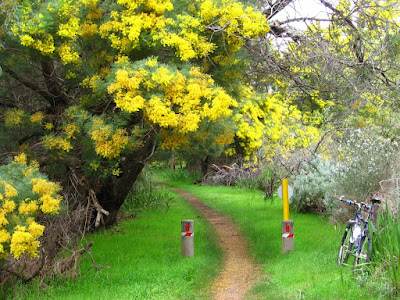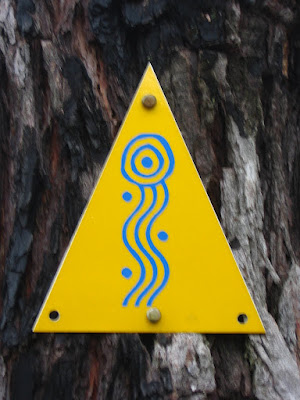After some planning, I am ready to roll.

Squinty was of no help.

The Munda Biddi Trail ("path through the forest" in Nyoongar Aboriginal language) is currently 1/3 complete: Stage 1 meanders 332 km (207.5 miles) from Mundaring to Collie over rolling terrain and takes between 7 to 10 days to comfortably complete. With the addition of Stages 2 and 3, this bush cycling trail will run 900 km (562.5 miles) to Albany, by the Southern Ocean. Official blurb here.

3-Map Pack of Stage 1. The maps regularly undergo revisions and updates; hence, make sure you have the latest copy. For example, Map 1 in the 3-map pack is edition 5, while Map 1 that is sold separately is edition 6. The Off-Road Cycling Guide is of limited value to experienced tourers.

Huck it! This reminds me of Henry W. Coe State Park. Across Highway 101 from Specialized in Morgan Hill, river crossings, overnight epics, trailers and panniers are part of the experience it offers. I guess this means the autarky-challenged, the self-styled prima donnas, and the Lance-Armstrong-wannabe-race-queens (who require support crew, cheerleaders, hugs, et cetera), should stay home :-P

:-D

Map 1a of Stage 1. Note: the map is incomplete and portions have been deliberately blurred or omitted to discourage cheapskates. Also, this is an (older) edition 5 map.

Elevation profile of Map 1a. Distance in kilometers and elevation in meters. (1.6 kilometers = 1 mile. 1 meter = 3.28 feet.)

Map 1b of Stage 1. Access to, and usage of, the Munda Biddi Trail is free. All proceeds from map sales are used to support the trail. The maps are printed on rip-proof plastic. If you plan to ride it, buy it.

Elevation profile of Map 1b. Distance in kilometers and elevation in meters. (1.6 kilometers = 1 mile. 1 meter = 3.28 feet.)

The ride begins in the Shire of Mundaring. The Nyoongar Aboriginals call this area, which lies 300 meters (984 ft) above sea level, "Mindah-lung," "a high place on a high place." More than a century old, the Mundaring Hotel lies a stone's throw from the beginning of the Munda Biddi Trail.

Across Jacoby Street is the Mundaring Community Sculpture Park, formerly the Mundaring Railway Station; to its rear, lies the northern terminus of the Munda Biddi Trail. Set in the style of railway sleepers, the sign is flanked by eucalyptus gum nuts, and scented by sprigs of sweetly fragrant Golden Wattle (Acacia pycnantha), Australia's national flower.

A closer look at the eucalyptus seeds or "gum nuts." A fountain in Kalamunda is modeled after this.
For those of us who were scouts:
What is a Woggle?(Official Souvenir Handbook for the Coming of Age Jamboree, held at Arrowe Park, Birkenhead, in 1920)
Every Scout knows but a stranger may not. You may know the Australians by their uniform . . . one distinctive feature is in place of a scarf knot, the Australians all have their scarves fastened with a "woggle," which is being interpreted is an Australian gum nut, the fruit of the Eucalyptus gum tree.

Another trail, the 16.6 km (10.4 mile) Mundaring Loop, also runs through here.

Point L on the Mundaring Loop Map, above the Mundaring Hotel (marked "Hotel").

Info shed. Taking a page from someone I choose to idolize, I opt to travel ultra-light — sans tent, sans sleeping bag, sans lantern — eschewing comfort and convenience for speed. Pack weight with 1.5 liters of water is a huckable 6.7 kg (14.74 lbs).

The start of the Munda Biddi Trail.
'Sent a copy of this to the guys at Cupertino Bike Shop. Vance is an incredible rider, he came in 2nd in the Davis Double Century (320 km) with a time of 8 hours 46 minutes. That's an average speed of 22.8 mph (36.5 km/h) over 200 miles (320 km) ^_^

Although its tracks are long gone, the railway continues to dominate the landscape: the old platform remains, with the first few hundred meters or so leading to the Railway Heritage Trail.

I was having too much fun slipping and sliding on the pea gravel to notice this abrupt turn, and ended up following Kep Track ("Gep" is the Nyoongar word for "water") eastward towards Northam, a 75 km (47 miles) trail. I had loads of fun, but, with the mandatory backtracking in, the mistake cost me an hour.

Back on the correct trail.

Wattles line the trail in golden swarths of the most brilliant yellow. The leaves on these are too small to belong to the Golden Wattle (Acacias pycnantha). These are more likely the Mulga Wattle (Acacias aneura). Its wood, harder than most other Acacias, was used to fabricate tools and weaponry by the Aboriginal people.

A closer look. They remind me of the bouquets of Scotch Brooms (Cytisus scoparius) along Estero Trail at Point Reyes, North California. Step up on a log among them and you will have your own maillot jaune.

The trail changes character infinitely. Here, it zigzags through trunks blackened by forest fires.

Then, you round a corner and become dazzled by an explosion of yellow crowns and living carpets of the most verdant green.

Of course, nothing is complete without climbing up the rolling hills of the Darling Scarp...

...with glades of swaying Hare's Foot Clovers (Trifolium arvense var. arvense) as your reward :-)

Further up, as lungs heave and legs burn, Blackboys (Xanthorrhoea) or grasstrees rustle in friendly encouragement.
Descending to Mundaring Weir Road.

Mundaring Weir Road. For those reluctant to shell out the clams for Mundaring Weir Hotel, there's the YHA Hostel.

Mundaring Weir Hotel. In the old days, when the trains called at Karda Mordo station, located higher up, beer kegs were unloaded and rolled down this very road to the hotel.

Speaking of kegs, these still come from Swan Brewery.

Entering the Shire of Kalamunda. In Nyoongar, "kala" means "home," and "munda," "forest." The eucalyptus gum nut has been adopted as its symbol.

A short climb leads up to Mundaring Weir.

A map of the immediate area.

Evidence of water shortage in this area is obvious. This is what the weir looks like when it is full.

Getting back on the trail.

Maybe it's my twisted sense of humor, but I found this sign hilarious; and, for the next hour or so, proceeded to torture the fauna with my rendition of Steppenwolf's "Born to be Wild."
Riding along North Ledge of the Mundaring Weir. Ivy's longer, L-bar ends proved to be a wise choice here.

Bibbulmun Track, a long-distance hiking trail, begins in this area, stretching 963 km (602 miles) from Kalamunda to Albany.

A 3 km downhill and a 5 km climb later.

Break time.

For coffee

It looks like something I'd rather not say, and tastes worse. It gives you bad gas as well; kangaroos started dropping dead around me.
To put it in another way, I'd rather chew NoDoz™ pills and suck on an old coffee filter instead. Bleah!

Lunch: really bad coffee and a really good coffee bun.

A slight draft between my fingers revealed a tear in my left glove. I bought these wonderful Pearl Izumi gloves from Any Mountain, Cupertino in November 1996. I guess they had a good run.

A gentle climb awaits after lunch at The Dell.
Bumpy video. Mounting the camera on the handlebar does little for shock isolation. Maybe I should get a lipstick camera (but that would mean more weight to lug around, more batteries to run flat, and more things to break).

Directional arrows such as these, posted regularly, identify the trail.

A closer look.

This symbol indicates that you are on the Munda Biddi Trail.

This directional symbol indicates a major change in direction ahead.

Other trails sometimes cut across or share the Munda Biddi Trail.

Pea-flowers (Fabaceae). A legume, like the peanut, when its petals flutter in a breeze, the shrub looks as if it's on fire.

Singletrack in a Jarrah (Eucalyptus marginata) forest. Jarrah wood, when green, is denser than water. Note to Dr. Watson, "Do not chop these for canoes."
Another bumpy video. I thought of mounting the camera on my helmet but was concerned about:
a) compromising the safety features of the helmet (you may think Dr. Frankenstein's monster looks cool with bolts in his head, but lets see you clear airport security);
b) getting the assembly whacked off by a low branch.

Pea gravel. These rocky spheroids can accumulate to a-foot-deep (30 cm) or more on trails. The locals liken the experience to riding on ball-bearings — I concur. Subaru World Rally Team Championship principal, David Lapworth, also expressed the same opinion.
The sound of tires rolling over the hard, loose beads is rather unique, similar to jiggling a jar of small, hard seeds or AirSoft™ pellets. Fortunately, the winter rains have packed these tiny spheres down somewhat; in summer, my 2-inch-wide Specialized Roll-X Pros are likely to be too skinny.
For geeks only, pea gravel also appears to have poor impact attenuation performance. 'Glad I didn't get to test it out :-D

Pea gravel come in various sizes.

The guys at the bike shops here deemed Ivy, "old school hardcore." Hmm... Is she really hardcore? I mean, what about this bike? It looks about ready to take on a Star Destroyer.

Tip for tourers: the awl in a Swiss Army knife safely enables the release — and reuse — of zip / cable ties.

Speaking of old school. How many people owned a Cateye CC-8000 ATC? This doesn't belong to me. My Cateye ATC is somewhere along Woodcutter's Trail, whacked off by a kleptomanic branch in 1995.

Umm... okay.

I don't think the headbolts unscrewed by themselves and the cylinder head went waltzing Matilda. Anyone want to handcrank this sucker over? Come on, it would be a piece of cake! There's no compression! :-D

Now that's what I call a gutted interior :-P

The parking brake is still engaged, but I don't think this sad heap is going anywhere.

Time for dinner and settle in for the night. With this special light, I see all sorts of things. I even see...

Oops! Forgot to set the flash to automatic. There you go.
Next day, more singletrack. There's a low branch in there somewhere.

Occasionally, the trail skirts the boundaries of farms and orchards.


A vineyard.

Fresh lemonade.

Fresh... umm... degreaser?
:-D

Spurs off the main trail that are reserved for hikers are cordoned off with barriers, and — more importantly — reflectors. Bare wood is practically invisible at night to cyclists. A reflector could mean the difference between a bone-breaking crash over the handlebar and a safe stop. This one time,

'Glad I'm not this poor sod.
One more video: a nice, long, gentle downhill through a Jarrah forest.
Epilogue:
Total distance: cyclo-computer 73.9 miles (118.2 km) / GPS dead
Total elevation climbed: Altimeter 6361 ft (1939 m)
Temperature range: 53 F to 70 F (11.7 C to 21 C)
Ride conducted solo.

No comments:
Post a Comment